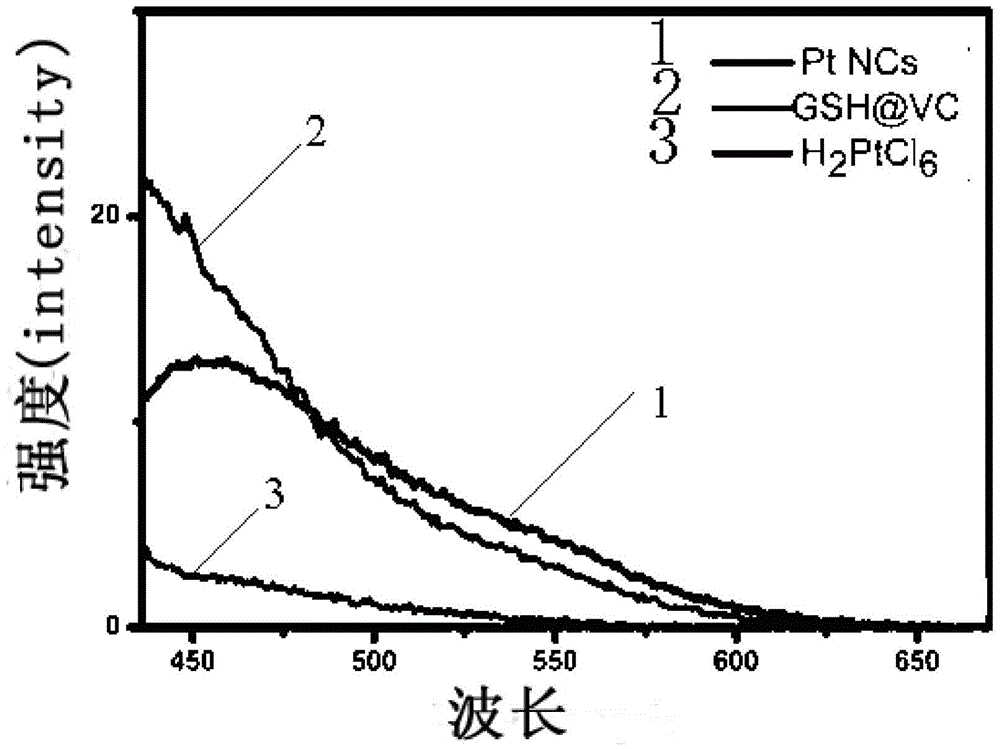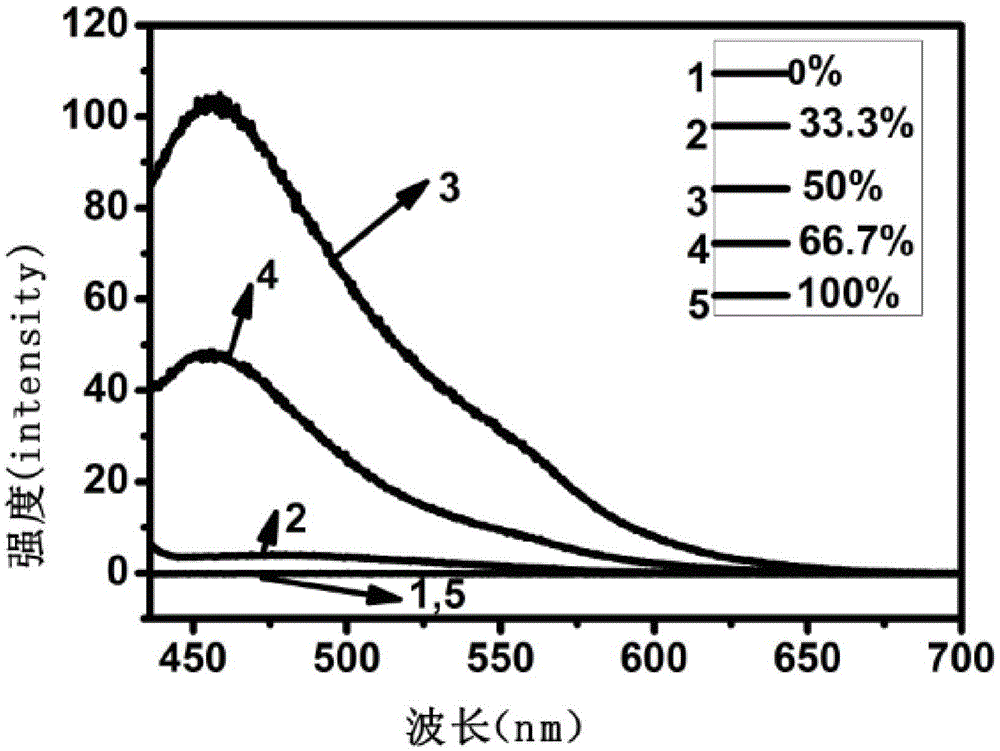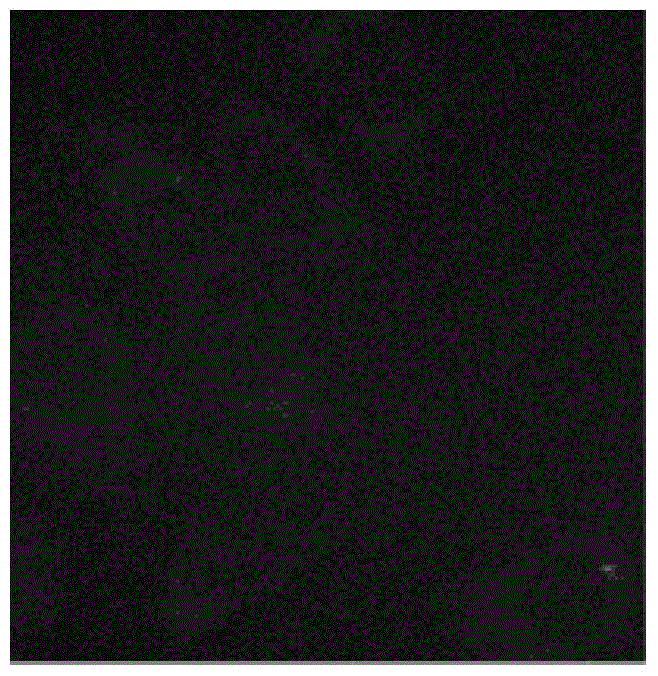Preparation method of platinum nanocluster and its application in tumor imaging agent and apoptosis agent
A platinum nano-apoptosis technology, applied in echo/ultrasound imaging agents, nuclear magnetic resonance/magnetic resonance imaging contrast agents, anti-tumor drugs, etc., to achieve broad medical application prospects, enhance targeting, and reduce cytotoxicity
- Summary
- Abstract
- Description
- Claims
- Application Information
AI Technical Summary
Problems solved by technology
Method used
Image
Examples
Embodiment 1
[0027] Example 1 A rapid one-step method for the preparation of platinum fluorescent nanoclusters based on reduced glutathione:
[0028] 1) Prepare reduced glutathione (GSH) and platinum salt solution (chloroplatinic acid is used in this example).
[0029] 2) Mix an aqueous solution of reduced glutathione with a concentration of 0.05 mol / L and an aqueous solution of ascorbic acid (vitamin C) with a concentration of 0.05 mol / L, and then add an aqueous solution of platinum reagent with a concentration of 0.05 mol / L, the volume ratio of the three solutions It is 1:1:1, mix well, then heat in a water bath at 37°C, and the reaction is complete when the solution turns orange.
[0030] The platinum fluorescent nanoclusters prepared in this example have good stability and a uniform particle size of about 1.2-2.0 nm.
[0031] The fluorescence spectrum of the platinum fluorescent nanoclusters prepared in this example is as follows figure 1 As shown, curve 1 in the figure is the fluore...
Embodiment 2
[0038] Example 2 A rapid one-step synthesis method for platinum fluorescent nanoclusters based on reduced glutathione:
[0039] 1) Prepare reduced glutathione (GSH) and platinum salt solution (potassium chloroplatinite is used in this example).
[0040] 2) Mix the reduced glutathione aqueous solution with a concentration of 0.1 mol / L and the ascorbic acid (vitamin C) aqueous solution with a concentration of 0.01 mol / L, and then add a platinum reagent aqueous solution with a concentration of 0.05 mol / L, the volume ratio of the three solutions It is 2:2:1, the three are fully mixed, and then heated in a water bath at 37°C, and the reaction is complete when the solution turns orange.
[0041] The platinum fluorescent nanoclusters prepared in this example have good stability and a uniform particle size of about 1.4-2.2 nm.
[0042] The emission wavelength of the platinum fluorescent nanoclusters prepared in this example is around 455nm, which is different from the Pt fluorescent ...
Embodiment 3
[0043] Example 3 A rapid one-step synthesis method for platinum fluorescent nanoclusters based on reduced glutathione:
[0044] 1) Prepare reduced glutathione (GSH) and platinum salt solution (ammonium chloroplatinite is used in this example).
[0045] 2) Mix the reduced glutathione aqueous solution with a concentration of 0.01 mol / L and the ascorbic acid (vitamin C) aqueous solution with a concentration of 0.1 mol / L, and then add a platinum reagent aqueous solution with a concentration of 0.05 mol / L, the volume ratio of the three solutions It is 2:1:1, the three are fully mixed, and then heated in a water bath at 37°C, and the reaction is complete when the solution turns orange.
[0046] The platinum fluorescent nanoclusters prepared in this example have good stability and a uniform particle size of about 1.4-2.3 nm.
[0047] The emission wavelength of the platinum fluorescent nanoclusters prepared in this example is around 457nm, which is different from the Pt fluorescent n...
PUM
 Login to View More
Login to View More Abstract
Description
Claims
Application Information
 Login to View More
Login to View More - R&D
- Intellectual Property
- Life Sciences
- Materials
- Tech Scout
- Unparalleled Data Quality
- Higher Quality Content
- 60% Fewer Hallucinations
Browse by: Latest US Patents, China's latest patents, Technical Efficacy Thesaurus, Application Domain, Technology Topic, Popular Technical Reports.
© 2025 PatSnap. All rights reserved.Legal|Privacy policy|Modern Slavery Act Transparency Statement|Sitemap|About US| Contact US: help@patsnap.com



